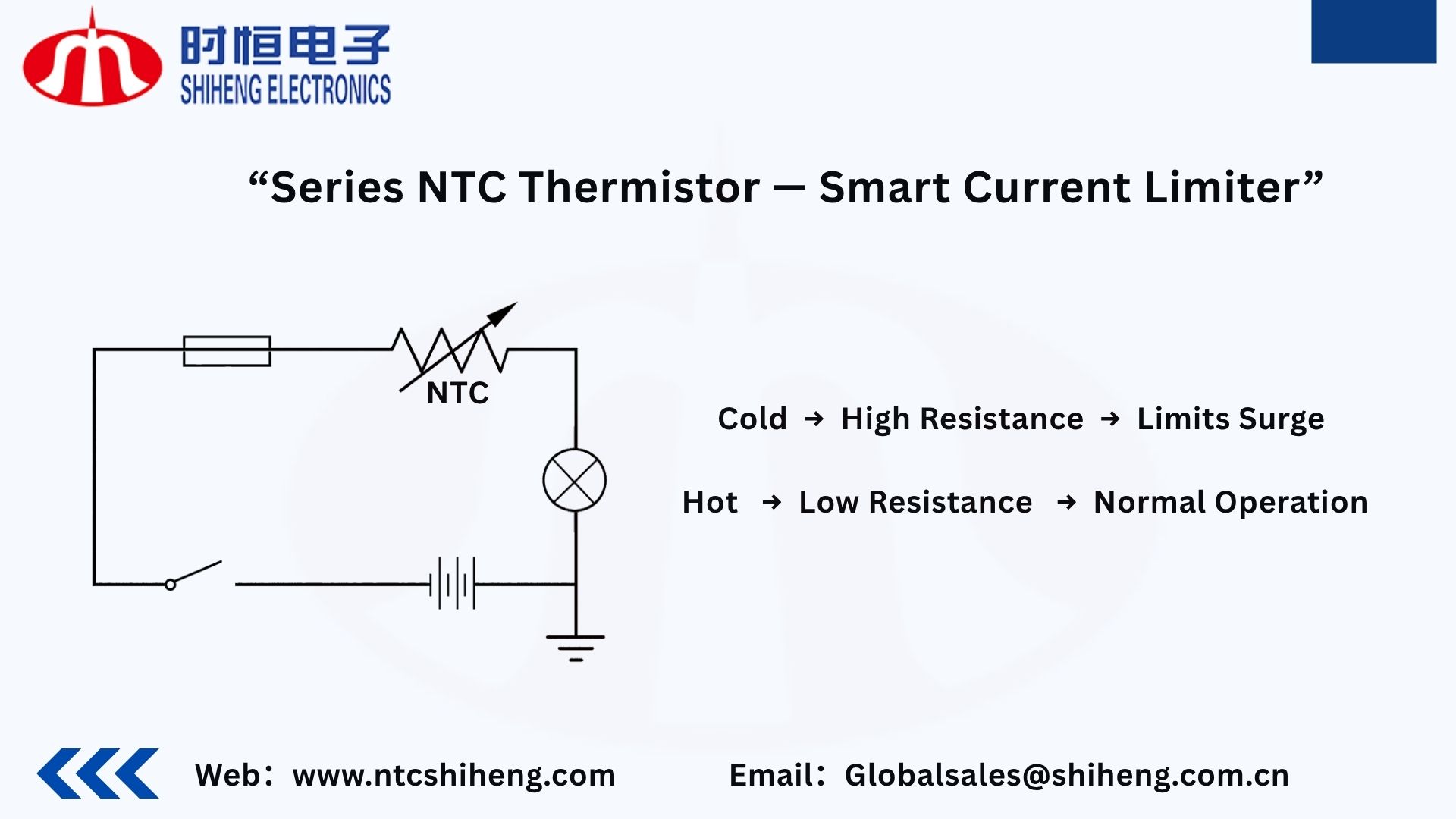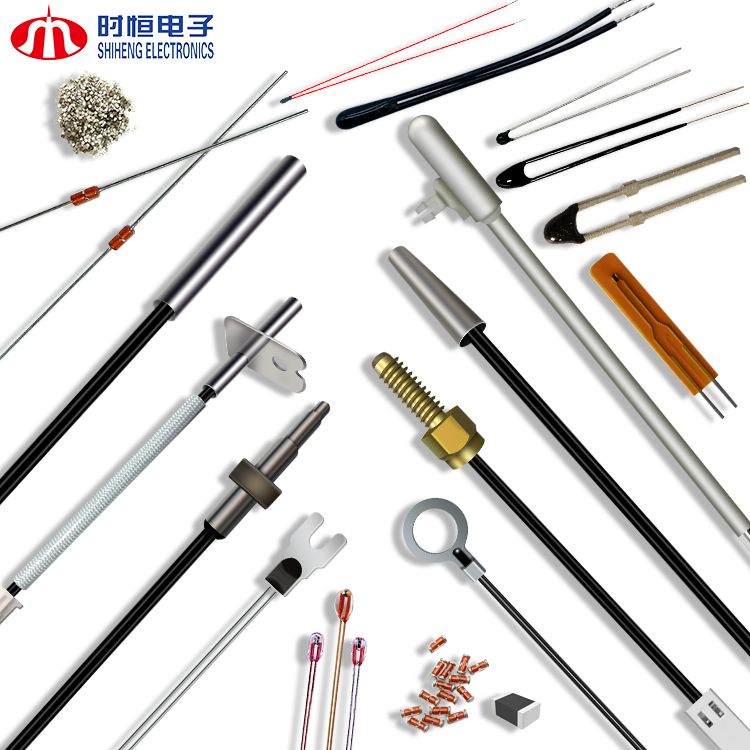Tại sao nhiệt điện trở NTC được sử dụng nối tiếp | Hướng dẫn bảo vệ chống sét lan truyền?
Nov 04, 2025Trong chu trình hoạt động của các thiết bị điện tử, khoảnh khắc bật nguồn là quan trọng nhất. Khi cấp nguồn, một dòng điện lớn sẽ chạy vào các tụ lọc, tạo ra xung điện áp có thể cao gấp hàng chục lần dòng điện hoạt động bình thường. Xung điện áp đột ngột này có thể làm hỏng các linh kiện như cầu chỉnh lưu, cầu chì và tiếp điểm rơle, đồng thời đẩy nhanh quá trình lão hóa hệ thống và rút ngắn tuổi thọ tổng thể của thiết bị.
Nhiệt điện trở NTC dòng điện khởi động là những thành phần chính bảo vệ chống lại dòng điện xung này. Nhưng tại sao chúng luôn phải được kết nối nối tiếp? Hãy cùng tìm hiểu vấn đề này qua bốn khía cạnh: nguyên lý, quy trình hoạt động, ưu điểm và hạn chế.
I. Nguyên lý cốt lõi — Hệ số nhiệt độ âm và logic chuỗi.
Nhiệt điện trở NTC (Hệ số nhiệt độ âm) có một đặc điểm chính: điện trở của chúng giảm khi nhiệt độ tăng.
Ở nhiệt độ phòng (trạng thái lạnh), điện trở của chúng tương đối cao. Khi dòng điện bắt đầu chạy qua, thiết bị nóng lên, nhiệt độ tăng lên và điện trở giảm mạnh — tạo thành nền tảng của việc giới hạn dòng điện động. Trong bất kỳ mạch điện nào, cách đơn giản nhất để giới hạn dòng điện là thêm một điện trở nối tiếp. Dòng điện đột biến NTC kết hợp nguyên lý này với độ nhạy nhiệt độ, hoạt động như một "biến trở thông minh" khi được nối tiếp với đường dây điện chính. Nó cung cấp khả năng bảo vệ giới hạn dòng điện trong quá trình khởi động, đồng thời hầu như không gây tổn thất trong quá trình vận hành ổn định.

II. Hoạt động nối tiếp — Từ “Giới hạn dòng điện” đến “Chạy điện trở thấp”.
Khi thiết bị được bật nguồn lần đầu, NTC ở trạng thái nguội và có điện trở cao. Điều này hạn chế dòng điện khởi động, bảo vệ cầu chỉnh lưu, tụ lọc và các linh kiện hạ lưu khác.
Khi NTC nóng lên do dòng điện chạy qua, điện trở của nó nhanh chóng giảm xuống chỉ còn vài phần mười ohm hoặc thấp hơn, cho phép dòng điện chạy qua bình thường với tổn thất công suất tối thiểu. Quá trình này bao gồm hai giai đoạn riêng biệt:
Việc tự động điều chỉnh này không yêu cầu mạch điều khiển bên ngoài, cung cấp cơ chế bảo vệ khởi động mềm đơn giản và đáng tin cậy cho các hệ thống điện tử.
III. Ưu điểm chính của cấu hình nối tiếp.

IV. Những hạn chế và cân nhắc về thiết kế.
(1) Thời gian phục hồi.
Sau khi tắt máy, NTC phải nguội đi để lấy lại điện trở cao. Nếu thiết bị khởi động lại quá nhanh, nhiệt điện trở vẫn ở trạng thái điện trở thấp, mất khả năng chống xung đột biến.
→ Giải pháp: Sử dụng thiết kế bỏ qua rơle — khi hệ thống ổn định, rơle sẽ làm ngắn mạch NTC, cải thiện độ tin cậy và loại bỏ tình trạng mất điện ở trạng thái ổn định.
(2) Thiết kế mất nhiệt và công suất.
Ngay cả khi hoạt động ổn định, vẫn sinh ra một lượng nhiệt nhỏ. Các nhà thiết kế nên đảm bảo NTC hoạt động trong phạm vi công suất định mức và bao gồm hệ thống thông gió hoặc tản nhiệt PCB đầy đủ.
(3) Độ nhạy nhiệt độ môi trường.
Điện trở ban đầu thay đổi đáng kể theo nhiệt độ. Trong môi trường rất lạnh, việc khởi động có thể khó khăn do điện trở cao; trong điều kiện nóng, điện trở có thể quá thấp để hạn chế dòng điện hiệu quả.
→ Giải pháp: Chọn NTC có giá trị B phù hợp hoặc sử dụng mạch khởi động dòng điện không đổi cho các ứng dụng nhiệt độ rộng.
V. Tóm tắt
Kết nối nối tiếp của loại nguồn Nhiệt điện trở NTC là yếu tố cơ bản cho hiệu suất hạn chế đột biến của chúng:
Sự kết hợp này làm cho nhiệt điện trở NTC trở thành một trong những giải pháp khởi động mềm tiết kiệm và đáng tin cậy nhất trong ngành điện tử hiện đại.
Công ty TNHH Điện tử Nanjing Shiheng chuyên nghiên cứu và phát triển (R&D) và sản xuất nhiệt điện trở NTC và cảm biến nhiệt độ. Danh mục sản phẩm của chúng tôi bao gồm: MF72, MF73T, MF74, MF75— bao gồm các kích thước từ Φ3 mm đến Φ40 mm, đáp ứng nhu cầu từ các thiết bị gia dụng nhỏ đến các hệ thống công nghiệp hàng kilowatt. Với độ chính xác cao, độ ổn định tuyệt vời và khả năng thích ứng rộng, Shiheng Electronics cung cấp các giải pháp chống sét lan truyền an toàn, hiệu quả và lâu dài cho khách hàng trên toàn thế giới.